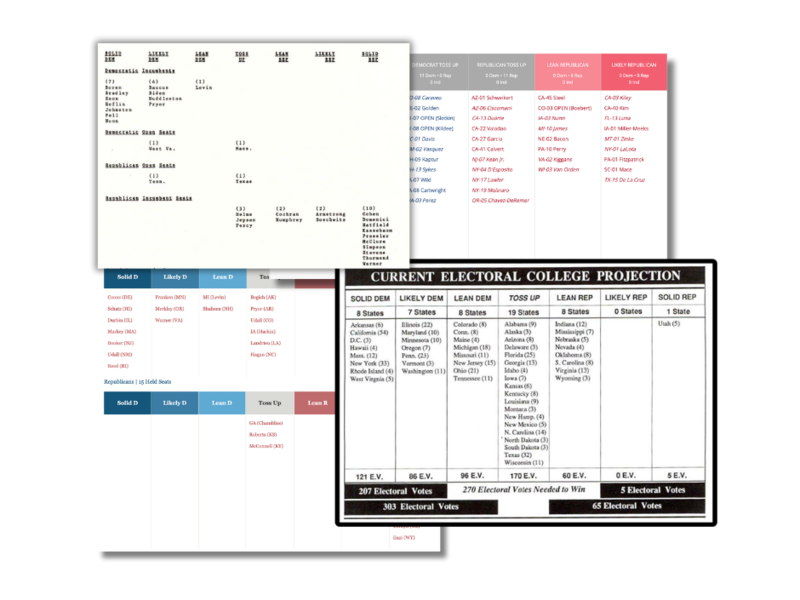
This article was originally published for the New York Times on October 6, 2020.
In an era of stark political polarization, it is difficult to find any one place that is a true microcosm of the country. But it is possible to find places on which the November election pivots. These communities that hold the key to the vote are as varied as the nation — and they reflect a notable inversion of its politics.
Polls now show Joe Biden with a surprising opportunity to capture Sun Belt suburbs that have voted reliably Republican for decades. He is also performing better than Hillary Clinton did in 2016 — but perhaps not as well as Barack Obama did in 2008 and 2012 — in heavily white, historically blue Frost Belt small towns and midsize cities where Donald Trump enjoyed a breakthrough in 2016.
These 10 bellwether counties — five in Sun Belt battlegrounds, five in the Frost Belt (loosely defined to include Iowa) — could point us toward each state’s winner. They run the gamut from meatpacking hubs to white-collar office parks, and from peach orchards to yacht-dense retiree havens. But there is something they all have in common: Their votes will matter a lot.
To win the White House, Mr. Biden will need to flip some combination of the 10 states Mr. Trump carried by less than 10 points in 2016 (in ascending order of margin): Michigan, Pennsylvania, Wisconsin, Florida, Arizona, North Carolina, Georgia, Ohio, Texas and Iowa. Mr. Biden has several paths to victory, and the first three states alone, in addition to every state won by Hillary Clinton, would be enough to put him into the Oval Office.
Conversely, Mr. Trump would likely need to win at least eight of those 10 states for a second term. A look at these bellwethers — all either tossups or leaning toward Mr. Biden — makes clear that Mr. Trump is in serious trouble.
Frost Belt
1. Kent County, Mich. (pop. 656,955)
Outlook: Lean Biden
The prosperous home of Steelcase office furniture, the DeVos family’s Amway empire and President Gerald Ford, Grand Rapids was long a Republican bastion owing to its deeply conservative Dutch Reformed roots. But its white-collar work force has soured on Mr. Trump’s party, and in 2016 Mr. Trump won Kent County by just three points, down from Mitt Romney’s eight-point margin.
Gov. Gretchen Whitmer, a Democrat, carried Kent County by four points in 2018, and Mr. Biden has a strong chance to win it in November. Private polls of the Third Congressional District, which covers much of Kent County, show Mr. Biden with a slight lead.
2. Wood County, Ohio (pop. 130,817)
Outlook: Tossup
Wood County, just south of Toledo, has multiple personalities. At its northern end are close-in Toledo bedroom communities. It has a strong affinity for rural culture: its county seat, Bowling Green, hosts the National Tractor Pulling Championships each August. And its diesel-fueled culture might be balanced out by Bowling Green State University (enrollment 19,905), a trove of Democratic votes.
Wood County is a decent bellwether of the state: Mr. Trump carried it by eight points in 2016, matching his statewide margin. In 2018, Senator Sherrod Brown, a Democrat, carried it by 11 points. The Biden campaign has run ads in the Toledo broadcast market, which conveniently covers part of Michigan, too.
3. Erie County, Penn. (pop. 269,728)
Outlook: Lean Biden
Philadelphia and Pittsburgh hog the spotlight, but Pennsylvania’s electoral ground zero might be its far northwest corner. The lakefront city of Erie is famous for assembling locomotives and packaging Smith’s meats. After decades of layoffs, it’s now home to a large population of refugees and the nation’s largest medical school by enrollment, Lake Erie College of Osteopathic Medicine.
Erie was also the site of a big Trump breakthrough in 2016: He carried the county by nearly two points, defying decades of Democratic dominance owing to a strong union heritage. Mr. Trump likely needs to win it again to keep Pennsylvania in his column. A February Mercyhurst University poll showed Mr. Biden leading Mr. Trump 48 percent to 44 percent in Erie County, and that was before Covid-19 made headlines.
4. Sauk County, Wis. (pop. 64,442)
Outlook: Lean Biden
Sauk County is a popular summer vacation destination and home to the state’s largest indoor water park. Its county seat, Baraboo, was the birthplace of the Ringling Brothers circus and houses the International Clown Hall of Fame and Research Center.
In 2016, Sauk County voted for a different showman — Mr. Trump — by 0.4 points after twice voting handily for Mr. Obama. In 2018, it voted for Gov. Tony Evers, a Democrat, by 10 points. Mr. Trump’s campaign is counting on its door-knocking efforts, in contrast to Mr. Biden’s mostly virtual outreach, to keep it red. But Wisconsin’s expanding Covid-19 “red zone” could throw a wrench in the Republican ground game.
5. Marshall County, Iowa (pop. 39,369)
Outlook: Tossup
Marshalltown, about 50 miles northeast of Des Moines, has been hit hard by the coronavirus: In April, it experienced Covid-19 outbreaks at both the 500-bed Iowa Veterans Home and the giant JBS Swift meatpacking plant. And in August, a derecho tore through town, damaging over 700 buildings. Rebuilding is likely to take years.
In 2016, Marshall County voted for Mr. Trump by eight points after voting twice for Mr. Obama by nine points. But the unpopularity of Gov. Kim Reynolds — her approval rating in August on her handling of the pandemic, was the lowest among all governors — is compounding Republicans’ problems this year. Statewide polls show both Mr. Trump and another Republican, Senator Joni Ernst, struggling to carry Iowa.
The meatpacking industry has attracted thousands of new Hispanic residents, many of whom could be first-time voters. From 2000 to 2019, the Hispanic or Latino share of Marshall County’s population surged to 23 percent from 9 percent.
Sun Belt
6. Maricopa County, Ariz. (pop. 4,485,414)
Outlook: Lean Biden
Maricopa County is crucial to the state outcome; it’s home to Phoenix and 62 percent of Arizona’s residents. The county is also a living portrait of why Arizona has become so competitive: It has a young and fast-growing Hispanic population, conservative-leaning retirees from California and elsewhere and a substantial number of Mormons who once reliably voted Republican but remain skeptical of Mr. Trump.
In 2016, Mr. Trump carried Maricopa by three points, down from Mitt Romney’s 11-point margin in 2012. In 2018, the Democrat Kyrsten Sinema carried it by four points en route to winning a Senate seat, aided by gains in highly professional suburbs.
A mid-September Monmouth University poll showed Mr. Biden leading Mr. Trump in Maricopa County 50 percent to 41 percent, a sign that Arizona’s largest county continues to trend left.
7. Pinellas County, Fla. (pop. 974,996)
Outlook: Lean Biden
With a median age of 48 and hordes of retirees from the Midwest, Pinellas, which includes St. Petersburg, has one of the oldest populations in America. In 2012, it voted for Mr. Obama by six points, but in 2016 Mr. Trump carried it by a single point, matching his statewide margin. So far, Mr. Biden appears to be polling better than Mrs. Clinton among older voters.
A late August survey by St. Pete Polls showed Mr. Biden leading Mr. Trump 54 percent to 40 percent in the 13th Congressional District, which covers most of Pinellas. Pinellas could offer an early assessment of Florida on election night. If Mr. Trump loses Pinellas, he’ll have to make up for it with gains elsewhere — especially among Cuban-American voters in Miami-Dade County.
8. Peach County, Ga. (pop. 27,546)
Outlook: Tossup
Peach County lives up to its name: It’s the home of two of the biggest peach-packing houses in Georgia. Politically, there may be no better bellwether in the state.
The population is 52 percent white and 44 percent Black, and its voting is racially polarized. In 2012, Peach County voted by seven points for Mr. Obama. But in 2016, Black turnout dropped sharply, and Mr. Trump won it by three points. Peach County could be a good indicator of whether the addition of Senator Kamala Harris to Mr. Biden’s ticket improves Black turnout.
So far, Mr. Trump is polling marginally better among Black voters, particularly young men, than he did in 2016. But Democrats hope that higher African-American engagement — including a strong surge in absentee-ballot requests — more than offsets it in places like Peach County.
9. New Hanover County, N.C. (pop. 234,473)
Outlook: Tossup
Wilmington’s most famous export might be Michael Jordan, but more recently its bustling movie and TV production industry has earned it the nicknames “Hollywood East” and “Wilmywood.” It was North Carolina’s largest city until the early 20th century, and today it might be its swingiest: Any entertainment industry leftism might be canceled out by a heavy military and retiree presence.
The county hasn’t voted for a Democrat for president since 1976, and in 2016, it voted for Mr. Trump by four points, approximating the state’s result. But it’s home to plenty of the types of voters with whom Mr. Biden is doing well nationally: older people, African-Americans and upper-income suburbanites (Whole Foods Market arrived in Wilmington in 2012). It could well go blue in 2020.
10. Collin County, Texas (pop. 1,034,730)
Outlook: Tossup
Everything is bigger in Texas — including the suburban backlash against Mr. Trump — and the political metamorphosis underway in Dallas’s white-collar northern suburbs is happening at a dizzying pace. Since 2010, Collin’s population has boomed 32 percent and is now one-sixth Asian.
In 2012, Collin County voted for Mitt Romney by 31 points. But in 2016, it voted for Mr. Trump by 17 points, and in the 2018 midterms Senator Ted Cruz carried it over Beto O’Rourke by just six points. Despite Texas’s old Wild West stereotype, the state now has one of the most metropolitan and diverse electorates in the country — and Mr. Trump’s erosion in its sprawling suburbs explains Mr. Biden’s surprising opportunity.
At least three polls conducted for lower-tier races show Mr. Biden tied or leading Mr. Trump in the Third Congressional District, which covers most of Collin County — a stunning development to Texas political analysts.
Bonus: Vigo County, Ind. (pop. 107,038)
Outlook: Lean Trump
Perhaps the most widely cited bellwether in the country, Vigo, which includes Terre Haute, is the only county in America that has voted for the winner of every presidential race since 1956. But it may lose that status in 2020: In 2016, it broke for Mr. Trump by a whopping 15 points, and it’s easy to see him carrying it again this fall, even if he loses the presidency.
Note: all populations are 2019 census estimates.










Subscribe Today
Our subscribers have first access to individual race pages for each House, Senate and Governors race, which will include race ratings (each race is rated on a seven-point scale) and a narrative analysis pertaining to that race.